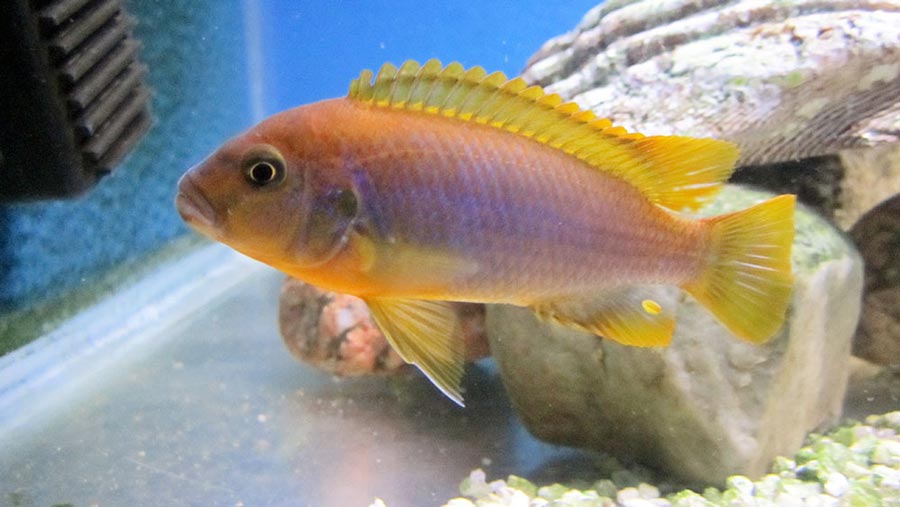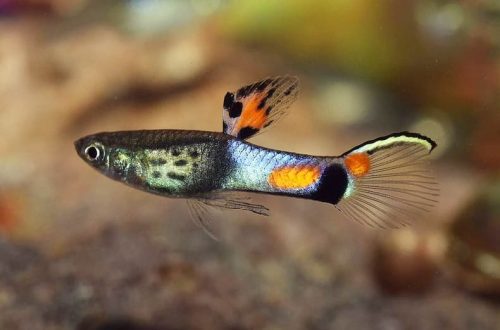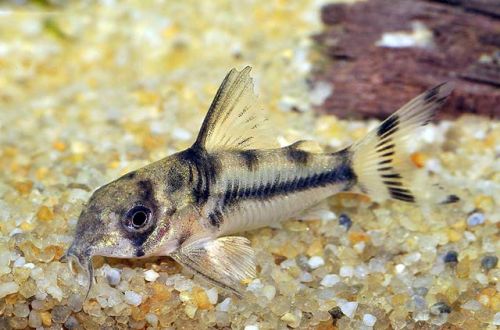
Lavender Mbuna
Sprenger’s Iodotropheus or Lavender Mbuna, also known as “Rusty” Cichlid, scientific name Iodotropheus sprengerae, belongs to the Cichlidae family. Endemic to Lake Malawi in East Africa, belongs to the Mbuna cichlid group. Inhabits shallow coastal areas of rocky beaches. An excellent choice for the beginner aquarist. The fish is easy to keep and breed, gets along well with species of similar size and temperament.

Contents
Description
Adult individuals reach a length of up to 8 cm. Sexual dimorphism is weakly expressed, males differ from females only in a large number of yellow dots on the anal fin, they are also somewhat larger and brighter in color. The color is bluish-orange, sometimes with a rich red tint. A similar feature is reflected in one of the popular names of this species – “Rusty” Cichlid.

Brief information:
- The volume of the aquarium – from 80 liters.
- Temperature – 25-29°C
- Value pH — 7.6–8.8
- Water hardness – medium to high hardness (10-25 dGH)
- Substrate type – sandy
- Lighting – moderate
- Brackish water – no
- Water movement is weak
- The size of the fish is about 8 cm.
- Nutrition – any with vegetable and protein supplements
- Temperament – conditionally peaceful
- Keeping in a harem with one male and several females
Food
It accepts most types of dry, frozen and live foods, but the diet must be balanced and combine protein and vegetable supplements, so you should give preference to specialized feeds for Malawian cichlids, which contain all the necessary elements.
Maintenance and care, arrangement of the aquarium
To successfully keep a small group of adult fish, you will need a tank of 80 liters or more. The design usually uses a sandy substrate and piles of stones, rock fragments, from which shelters are formed in the form of caves and crevices. The presence of plants is not necessary, although unpretentious Anubias and Vallisneria can be planted as decorations.
Water conditions have high pH and dGH values. The placement of a productive filtration system, along with a weekly replacement of part of the water with fresh water (10–15% of the volume), will help maintain hydrochemical conditions at the proper level. It is advisable to purchase filters with filter materials that increase the hardness of the water in order to avoid strong fluctuations in dGH.
Behavior and Compatibility
One of the least aggressive among the Mbuna cichlids, therefore it can be combined with other calm species of Lake Malawi, as well as members of other families that can live in similar conditions. As for intraspecific relationships, males compete with each other for females and territory. The optimal choice is one male Lavender Mbuna and several females.
Breeding / breeding
The appearance of the offspring of Iodotropheus Sprenger in favorable conditions is very likely. With the onset of the mating season, the male chooses a certain area at the bottom of the aquarium – the future spawning place, usually a flat stone. Then proceeds to active courtship. At this time, its color becomes brighter, which is a clear sign of the onset of the breeding season.
When the female is ready, she accepts courtship and lays several dozen eggs, which she immediately takes into her mouth. At this moment, the male releases the seed and the eggs are fertilized already in the mouth. He no longer participates in the protection and care of offspring.
The entire incubation period and the first weeks of life, the fry spend in the mouth of the female. At this time, she does not eat anything and can noticeably lose weight. If before spawning the food supply was not regular or the diet was poor, then the female is likely to release the fry earlier, in the worst case, she will eat them.
During spawning, it is advisable to transplant the neighbors in the aquarium into another tank (if any) in order to avoid possible attacks from the male, or vice versa, place cichlids there, and return them back at the end of the mating season.
For the safety of fry in the future, they are kept in a separate aquarium with identical water conditions.
Fish diseases
The main cause of most diseases is unsuitable living conditions and poor-quality food. If the first symptoms are detected, you should check the water parameters and the presence of high concentrations of hazardous substances (ammonia, nitrites, nitrates, etc.), if necessary, bring the indicators back to normal and only then proceed with treatment. Read more about symptoms and treatments in the Aquarium Fish Diseases section.





